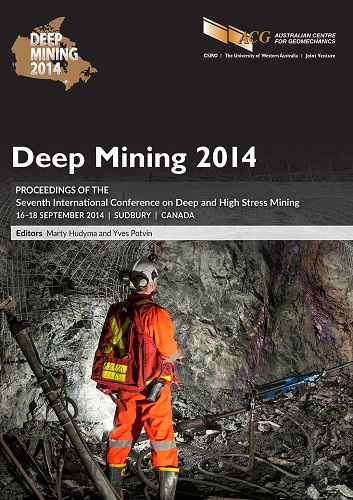Effect of deep mine temperature conditions on the heat development in cemented paste backfill and its properties

|
Authors: Fall, M; Wu, D; Pokharel, M |
DOI https://doi.org/10.36487/ACG_rep/1410_39_Fall
Cite As:
Fall, M, Wu, D & Pokharel, M 2014, 'Effect of deep mine temperature conditions on the heat development in cemented paste backfill and its properties', in M Hudyma & Y Potvin (eds), Deep Mining 2014: Proceedings of the Seventh International Conference on Deep and High Stress Mining, Australian Centre for Geomechanics, Perth, pp. 559-573, https://doi.org/10.36487/ACG_rep/1410_39_Fall
Abstract:
As ore reserves available at shallow depths are diminishing in several countries, underground mining operations are moving to greater depths. This greater depth is naturally associated with heat influx increases because of the geothermal gradient. The exposed rock mass is the primary heat load source in any deep level mining operation. In this study, a numerical model is developed and validated to assess the heat transfer between deep mine rocks and cemented paste backfill (CPB) structures, as well as the heat development in CPB structures in deep mine temperature conditions. The numerical modelling results have shown that the initial deep mine rock temperatures significantly affect the heat or temperature development inside the CPB. Furthermore, experimental tests were carried out to study the effect of high temperatures on CPB properties. Different types of CPB specimens were tested at different curing times and temperatures. The strength, deformation behaviour, resistance to sulphate attack and hydraulic conductivity of these CPBs were evaluated by laboratory tests. Results showed that deep mine temperatures have a significant effect on the properties of CPB. Increasing the curing temperature increases the rate of CPB strength development and leads to higher early CPB strength and lower binder consumption. Moreover, the effect of temperature depends on the binder type, the curing time, the water content and the sulphate content of the CPB. Hence, the deep mine temperature is an important factor that should be considered in deep mine CPB operations in order to better optimise CPB mixtures and design cost-effective and durable CPB structures.
References:
Buffo-Lacarriere, L, Sellier, A, Escadeillas, G & Turatsinze, A 2007, ‘Multiphasic Finite Element Modeling of Concrete Hydration’, Cement and Concrete Research, vol. 37, no. 2, pp. 131-138.
De Souza, E & Hewitt, A 2005, ‘The contribution of cemented backfill to heat loads in mines’, Proceedings of the Eight International Mine Ventilation Congress, Australasian Institute of Mining and Metallurgy, Carlton South, pp. 87-93.
Escalante-Garcia, JI & Sharp, JH 2001, ‘The Microstructure and Mechanical Properties of Blended Cements Hydrated at Various Temperatures’, Cement and Concrete Research, vol. 31, pp. 695-702.
Fall, M & Adrien, D, Celestin, JC, Pokharel, M & Touré, M 2009, ‘Saturated Hydraulic Conductivity of Cemented Paste Backfill’, Minerals Engineering, vol. 22, no. 15, pp. 1307-1317.Fall, M, Célestin, JC, Pokharel, M & Touré, M 2010, ‘A contribution to Understanding the Effects of Temperature on the Mechanical Properties of Cemented Mine Backfill’, Engineering Geology, vol. 14, no. 3-4, pp. 397-413.
Fall, M & Pokharel, M 2010, ‘Coupled Effect of Sulphate and Temperature on the Strength Development of Cemented Backfill Tailings: Portland Cement Paste Backfill’, Cement and Concrete Composite, vol. 32, no. 10, pp. 819-828.
Hassani, FP & Archibald, J 1998, Mine Backfill, Canadian Institute of Mine, Metallurgy and Petroleum, on CD-ROM.
Levens, RL, Marcy, AD & Boldt, CMK 1996, Environmental Impacts of Cemented Mine Waste Backfill, United States Bureau of Mines, Washington.
Maltais, Y & Marchand, J 1997, ‘Influence of Curing Temperature on Cement Hydration and Mechanical Strength Development of Fly Ash Mortars’, Cement and Concrete Research, vol. 27, pp. 1009-1020.
Nasir, O & Fall, M 2010, ‘Coupling Binder Hydration, Temperature and Compressive Strength Development of Underground Cemented Paste Backfill at Early Ages’, Tunnelling and Underground Space Technology, vol. 25, no. 1, pp. 9-20.
Pokharel, M & Fall, M 2010, ‘Coupled Thermo-Chemical Effects on the Strength Development on Slag-Paste Backfill Materials’, ASCE Journal of Materials in Civil Engineering, vol. 23, no. 5, pp. 511-525.
Rawlins, CA & Phillips, HR 2001, ‘Reduction of mine heat loads’, in S Wasilewski (ed.), Proceedings of the 7th International Mine Ventilation Congress, Research & Development Center for Electrical Engineering and Automation in Mining, pp. 381-389.
Schindler, AK & Folliard, KJ 2003, ‘Influence of supplementary cementing materials on the heat of hydration of concrete’, in DA Lange & KL Scrivener (eds), Proceedings of the 9th Conference on Advances in Cement and Concrete, pp. 17-26.
Wang, XY & Lee, HS 2010, ‘Modeling the Hydration of Concrete Incorporating FA or Slag’, Cement and Concrete Research, vol. 40, no. 7, pp. 984-996.
Williams, TJ, Denton, DK, Larson, MK, Rains, RL, Seymour, JB & Tesarik, DR 2001 Geomechanics of Reinforced Cemented Backfill in an Underhand Stope at the Lucky Friday Mine, Mullan, Idaho, Report of Investigations 9655, U.S. Department of Health and Human Services, Services.
Wu, D, Fall, M & Cai, S-J 2012, ‘Coupled Modeling of Temperature Distribution and Evolution in Cemented Tailings Backfill Structures that Contains Mineral Admixtures’, Journal of Geotechnical and Geological Engineering, vol. 30, no. 4,
pp. 935-961.
Wu, D, Fall, M, & Cai, S-J 2013, ‘Numerical Modelling of Thermally and Hydraulically Coupled Processes in Hydrating Tailings Backfill Columns’, International Journal of Mining, Reclamation and Environment, vol. 28, no. 3, pp. 173-199.
© Copyright 2025, Australian Centre for Geomechanics (ACG), The University of Western Australia. All rights reserved.
View copyright/legal information
Please direct any queries or error reports to repository-acg@uwa.edu.au
View copyright/legal information
Please direct any queries or error reports to repository-acg@uwa.edu.au